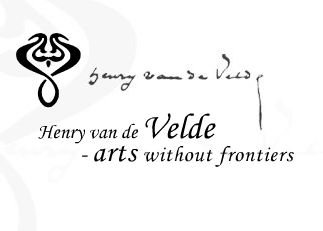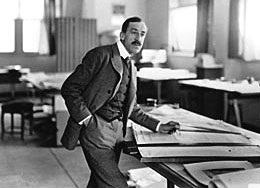| |
| Van de Velde's Disciples in the Artistic Society of Breslau |
| |
At first, my intention was to evaluate the reception of Henry van de Velde's works in Breslau (nowadays: Wrocław) during the period of the first thirty years of the twentieth century. At that time the city was an important cultural centre in Germany. It had a population over 400.000 inhabitants and it was the second biggest (after Berlin) city in Prussia. However, having researched the literature available in Poland, I had to limit my task and write about one documented van de Velde's stay in Breslau. I also decided to write about life and artistic activity of his two direct disciples: Li Vinecky–Thorn (1867 – 1952) and Josef Vinecky (1882 – 1949), a married couple connected to the Academy of Arts in Breslau.
There used to be two leading institutions in the artistic circle of Breslau from the beginning of the twentieth century until the end of the thirties, i. e. to the moment when the second world war began. Two schools of artistic craft influenced the artistic environment of the city: the Royal School of Arts and Artistic Industry (Königliche Kunst- und Kunstgewerbeschule) where Li Vinecky-Thorn and Josef Vinecky worked, and its competitive institution, the Town School of Craft and Artistic Industry (from 1900 to 1910 its name was the Craft School).
However, no institution would mean anything without the people running it. The position of Breslau in the artistic world was mainly influenced by the artists and teachers of the Art Academy and a group of people who had professional and informal contacts to the Academy and who gathered around the salon of Toni and Albert Neisser, collectors and art patrons. (The Neisser's salon was regarded to be the spiritual and scientific centre of Breslau).
The Royal School of Arts and Artistic Industry – as a school – was brought to life in 1871, when, at first, under the name of the provincial School of Arts it was founded in Breslau by Friedrich Wilhelm II, according to the plan of decentralization of the artistic education of Berlin. It was founded to educate craftsmen in the region. This is why from the very beginning the school's programme was to integrate theory of the applied arts with the free arts education. This integration of arts and the so called artistic industry (designing for crafts and industry) was always to be close during the whole period of the school development, especially under the administration of Hans Poelzig from 1903. The name of the provincial School was changed into Royal in 1875, and in 1911 – which was already under Poelzig's administration - it became the Academy. In 1918 it changed its name into the State Academy of Arts and Artistic Industry. Starting from the times of administration of Poelzig, an outstanding architect and interior decoration designer, the school consequently followed the path showed by its predecessors, especially by Herman Kühn. In other words, it followed the direction towards modernity and stressed the importance of practice and the needs of the regional environment. The school headmasters: August Endell (architect) and Oscar Moll (painter) supported the development of the applied disciplines, integrated with the free arts, and this is why the school was perceived to be progressive and cooperating with the famous Bauhaus. This required employing artists who were able to meet the innovatory programme assumptions, and Li Vinecky - Thorn and Josef Vinecky were one of them.
The school participated actively in the artistic life of Breslau. Close cooperation with the Silesian Museum of Artistic Industry and Antiquities directed by Karl Maser gave way to yearly exhibitions of artistic craft where the students' works were confronted with the works of German and Silesian artists. On this occasion, at first in 1900, Masner initiated a series of guest lectures, promoting the latest achievements of artistic crafts. Henry van de Velde was one of the guest lecturers, and he presented a lecture entitled "My view at arts". The Academy took part in all the important regional exhibitions, including the Great Exhibition of Arts in Breslau in 1920, and a very prestigious exhibition (1929) entitled "Living and Working Area" (Work- und Werkraum Ausstellung" WuWa). Apart from that, involving the students into commissioned practical works (for example interior decorating of the Town Hall in Lwówek Śląski or the objects built for WuWa) was a bold educational step.
In spring 1926 Else Amanda Karolina Horn (her married name was Li Vinecky–Thorn) started to work in the Academy as a director of the weaving workshop. Li Vinecky Thorn (1867 – 1952) had studied weaving both in the School of Artistic Industry in Krefeld and at van de Velde's seminary. From 1907 – 1909 she already had her own weaving studio in the School of Artistic Crafts in Weimar, under administration of van de Velde. Her main fields of interests were: weaving, embroidery, batik, fabric printing and bookbinding.
At van de Velde's school Li Vinecky's ambitious scientific and artistic aims could not go together with practical (commercial) requirements. She had financial difficulties and even her master was not able to help her. Feeling disappointed with the necessity of dealing with commercial tasks she stopped managing her workshop but the money she got from selling the objects helped her husband Joseph Vinecky establish a pottery manufacture in Sinn near Herborn. The Vineckys moved there in 1909. Thorn developed her creativeness in the textile field, obviously influenced by van de Velde: respecting the workshop's technical rules and modern approach to the issue of form and decorative motives.
Having started to work at the Academy in Breslau she started to cooperate with other teachers, for example Oskar Moll and Hans Scharoun, who could use her workshop tools to produce their own projects. Li Vinecky is much respected for her mastery of the logics of a textile work and for applying the cubist and geometrised motives. Li Thorn also participated in the Academy's team projects – she was much successful with her textile works which decorated the interiors of a "sky-scraper" designed by A. Rading for the WuWa exhibition.
In 1928 Joseph Vinecky started to work for the Academy and he became the director of the woodwork workshop. He was earlier known as a sculptor and ceramic artist. It was a bold decision, as Vinecky had not had any previous experience in furniture designing, this is why some opinions could be heard about Vinecky's lack of competence. Vinecky proved it quickly that he could achieve success in this area as well. It was thanks to his education and cooperation with Van de Velde who approached the designing issues from the point of view of many artistic disciplines.
Joseph Vinecky (1882 -1949) was the son of a wheelwright. In 1897-1901 he studied sculpture at Mander's in Troy. In 1902 he joined van de Velde's artistic-industrial seminary in Weimar, later on it changed into the School of Artistic Industry. At first Vinecky was a sculptor at the faculty and van de Velde's secretary. Later on, from 1909 he was a director of the ceramic workshop and the workshop of artistic-industrial designing for other artistic craft branches. Having asked for permission to leave his post, Vinecky received positive references from van de Velde. He was described as an enthusiastic worker and a person able to work independently in all the branches of artistic and industrial design which are integrated to sculpture. During his stay in the School of Artistic Industry Vinecky also gained experience in his contacts with industry. He produced works for Volkswagenmuseum, supervised building monuments in Jena and Antwerp, a fountain for Osthausmuseum, and the like. He also witnessed all the organizational and syllabus changes at van de Velde's school.
Having moved with his wife Li Thorn to Sinn, he established his own ceramics workshop. This was the time of developing and forming his genuine personality as a designer. He was a successful designer of the ceramic tiles for Town Bath in Wiesbaden in 1913, his designs referred to Parisian cubism and Russian constructivism and this made it easier to cooperate with others, for example with Maks A. Pfeiffer (china workshop artist), Ernst Barlach and Gerard Marks (sculptors) and Alexei Jawlinski (painter). In 1919 – 1927 he worked in Wiesbaden and he was also teaching in a private artistic school. This was a period of an intensive sculpture work, influenced by the Barlach stylistics
in the climate of German expressionism. The fact that his wife had left for Breslau and started to work at the Academy there made Vinecky accept the offer to become a director of the woodwork workshop at this Academy.
During his work there he designed and produced simple wooden pieces of furniture (with visible analogies to van de Velde's style). These were the pieces of furniture which were partially folded, and which were designed specially for small flats and suitable for mass production. He also designed furniture from metal pipes, similar to the designs of Marcel Breuer from Bauhaus. At the same time, like his master, Vinecky designed metal and glass utensils for everyday use and fabric motives. In 1930 he extended his woodwork workshop into the workshop of material modelling and started to produce ceramics. He also experimented with new artificial materials (plexiglas, poliester) which he used for producing the objects according to his design. It is worth mentioning that Vinecky took part in an exhibition organised in 1929 in Breslau, by the Silesian branch of Werkbund, with the support of the Academy. The exhibition presented an experimental housing estate, designed and raised by a group of modern architects, and the interiors of some buildings were equipped by the workshops of the Academy. Apart from that, Vinecky had his separate section at the exhibition: "Metals, wood and insulating materials" and he also contributed to another section presenting living area interiors and furniture. The pieces of furniture designed by Vinecky had a sign of his own stylistics, although they were referring to van de Velde's works and the works of the Russian constructivists. The pieces of furniture found their place in the interior of a tenement house designed by A. Rading. Their constructive form was consolidated by bold colours and they were regarded to be typical for the workshops of the Academy.
Joseph Vinecky had modern views on the issues of everyday use products designing. Today he could have been one of the forerunners of modern design integrated with the marketing issues. He stressed the role of psychological factor in the reception of products. He was thinking about creating the positive attitude to the product. His – and other Academy workers' - success in the designing branch was possible thanks to the atmosphere of modernity and progess created by the authorities and the staff of the Academy. This approach and close connections to Bauhaus in Dessau (many artists with leftist views came to work from there to Breslau) gave way to repressive measures by the state authorities and finally the Academy had to be closed down in 1932. The Vineckys and many other Academy workers, as foreigners, had to leave the city. Many other friends of theirs had to emmigrate abroad.
Having lived in Berlin for a few years Vinecky and his wife finally moved to Czechoslovakia in 1937 where in 1937 -1939 he was the professor at the School of Artistic Craft in Bratislava, then he lived in Prague and finally settled down in Olomouc. In 1946 he was one of the pioneers who brought to life the Institute of Artistic Education at the University of Olomouc. He worked there until 1948 when, under the communist authorities pressure, he ended up his pedagogical career. Josef Vinecky left for Prague, where he died about a year later. Li Thorn, his life companion and artistic partner, died in Prague, too, three years later.
Andrzej Saj
Academy of Fine Arts Wrocław / Poland
|



